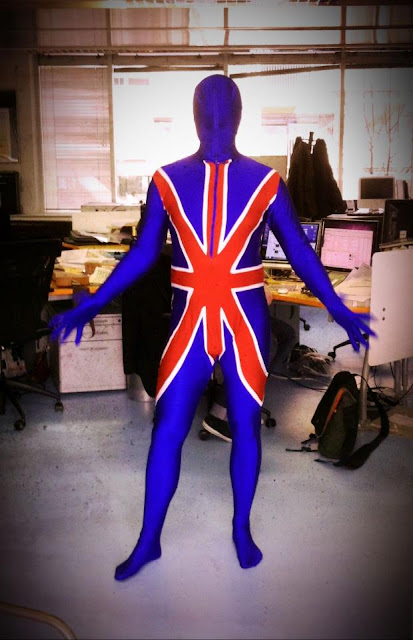2012 is undoubtedly a big year for sport in London.
With the Golden Jubilee sparking community spirit and the ever looming Olympics fast approaching, four of the finest athletes from TBCH were inspired to take to the track for this year's London Marathon.
Jules - The experienced one
Jules is a keen runner with three marathons under her belt already. She kept everyone in the TBCH team motivated enough to keep training!
Richie - The one with the best outfit
This was Richie's 8th marathon. As it's old hat for him now, he decided to reignite the spark by running as a Union Jack morph man. We were sure he'd get on telly looking like this, but sadly no:
Lou - The one who did it for a great reason
Lou trained very hard for this, her second marathon. She pulled out all the stops in her training and was even seen limbering up in Paris (while on holiday!) That's dedication for you.
Nic - The one with the gross blisters
And then there's me! This was my first marathon and my feet have told me never again! I've quite possibly spent more on equipment, medical supplies and doctor's appointments than I've actually raised for my charity...
With charity being our main motivation to run the marathon, it made me reconsider the importance of such events and the eventual benefits.
Basically, how do you tackle to tricky subject of asking for money?
Thankfully, the days of carrying a dog-eared sponsorship form round the office and pleading for loose change have gone.
Just Giving pages have made it easier to help raise money. One simple politely worded email forwarded to the whole agency, building, family and friends can see your sponsorship total increase in a matter of minutes.
But how do the charities themselves tackle this problem in their everyday fundraising?
Just Giving pages can turn into a popularity contest with some people - highlighting who has the most 'generous' friends.
How do charities with a small donor base compete with larger well-known organizations (after all, you can't just bombard your current donors all the time)?
How do charities get more 'friends'?
Then you get the donors who only sponsor you because they want you to sponsor them (and they make this very clear when doing so!)
Do these people expect to get something in return if they donate to charities directly?
Do charities need to think about how to engage with this audience differently?
I don't have the answers for you right now.
(But you just get to thinking when you're running for four hours solid, that's all.)





